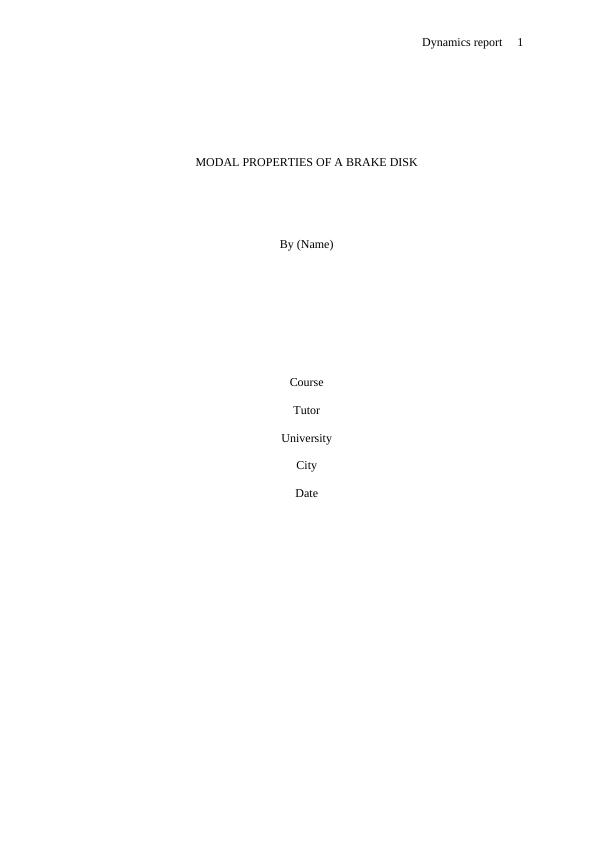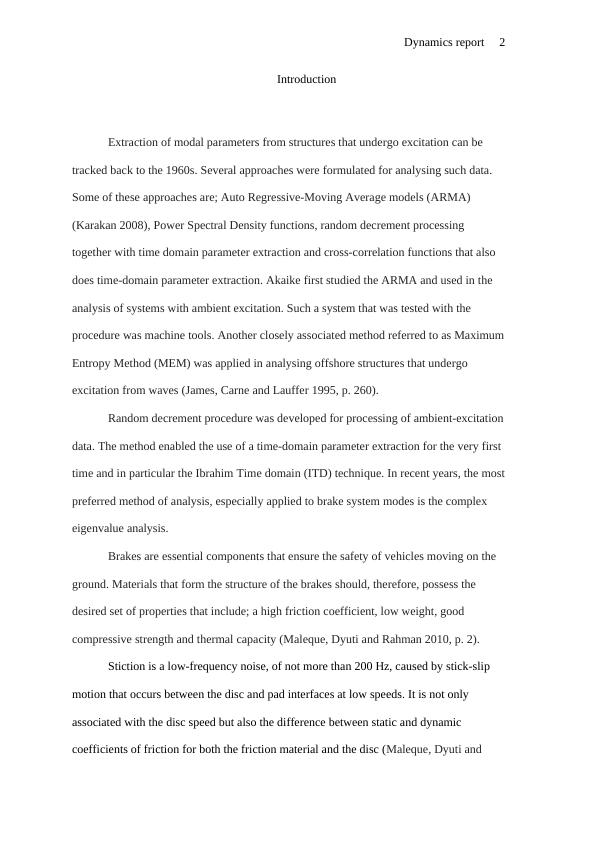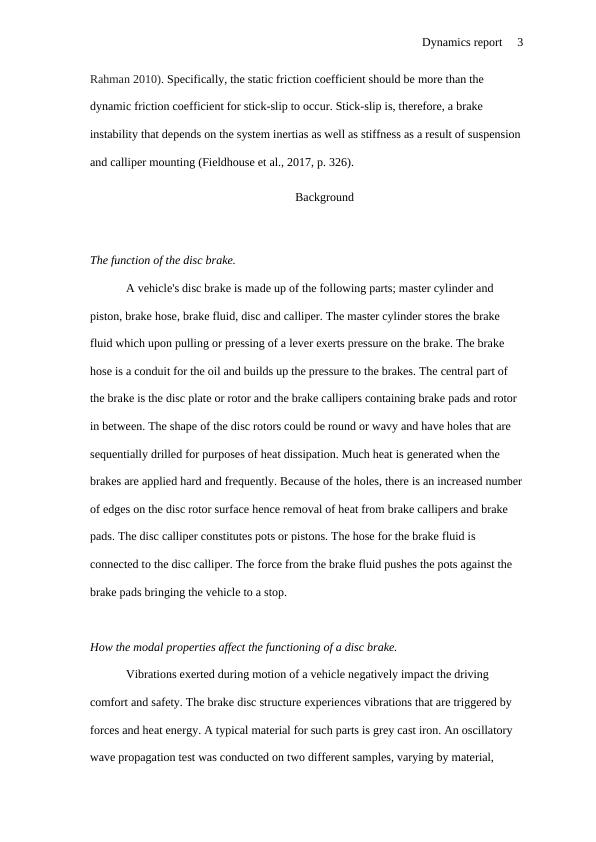Modal Properties of a Brake Disk: Analysis and Impact on Functioning
Added on 2023-06-03
11 Pages2082 Words233 Views
Dynamics report 1
MODAL PROPERTIES OF A BRAKE DISK
By (Name)
Course
Tutor
University
City
Date
MODAL PROPERTIES OF A BRAKE DISK
By (Name)
Course
Tutor
University
City
Date

Dynamics report 2
Introduction
Extraction of modal parameters from structures that undergo excitation can be
tracked back to the 1960s. Several approaches were formulated for analysing such data.
Some of these approaches are; Auto Regressive-Moving Average models (ARMA)
(Karakan 2008), Power Spectral Density functions, random decrement processing
together with time domain parameter extraction and cross-correlation functions that also
does time-domain parameter extraction. Akaike first studied the ARMA and used in the
analysis of systems with ambient excitation. Such a system that was tested with the
procedure was machine tools. Another closely associated method referred to as Maximum
Entropy Method (MEM) was applied in analysing offshore structures that undergo
excitation from waves (James, Carne and Lauffer 1995, p. 260).
Random decrement procedure was developed for processing of ambient-excitation
data. The method enabled the use of a time-domain parameter extraction for the very first
time and in particular the Ibrahim Time domain (ITD) technique. In recent years, the most
preferred method of analysis, especially applied to brake system modes is the complex
eigenvalue analysis.
Brakes are essential components that ensure the safety of vehicles moving on the
ground. Materials that form the structure of the brakes should, therefore, possess the
desired set of properties that include; a high friction coefficient, low weight, good
compressive strength and thermal capacity (Maleque, Dyuti and Rahman 2010, p. 2).
Stiction is a low-frequency noise, of not more than 200 Hz, caused by stick-slip
motion that occurs between the disc and pad interfaces at low speeds. It is not only
associated with the disc speed but also the difference between static and dynamic
coefficients of friction for both the friction material and the disc (Maleque, Dyuti and
Introduction
Extraction of modal parameters from structures that undergo excitation can be
tracked back to the 1960s. Several approaches were formulated for analysing such data.
Some of these approaches are; Auto Regressive-Moving Average models (ARMA)
(Karakan 2008), Power Spectral Density functions, random decrement processing
together with time domain parameter extraction and cross-correlation functions that also
does time-domain parameter extraction. Akaike first studied the ARMA and used in the
analysis of systems with ambient excitation. Such a system that was tested with the
procedure was machine tools. Another closely associated method referred to as Maximum
Entropy Method (MEM) was applied in analysing offshore structures that undergo
excitation from waves (James, Carne and Lauffer 1995, p. 260).
Random decrement procedure was developed for processing of ambient-excitation
data. The method enabled the use of a time-domain parameter extraction for the very first
time and in particular the Ibrahim Time domain (ITD) technique. In recent years, the most
preferred method of analysis, especially applied to brake system modes is the complex
eigenvalue analysis.
Brakes are essential components that ensure the safety of vehicles moving on the
ground. Materials that form the structure of the brakes should, therefore, possess the
desired set of properties that include; a high friction coefficient, low weight, good
compressive strength and thermal capacity (Maleque, Dyuti and Rahman 2010, p. 2).
Stiction is a low-frequency noise, of not more than 200 Hz, caused by stick-slip
motion that occurs between the disc and pad interfaces at low speeds. It is not only
associated with the disc speed but also the difference between static and dynamic
coefficients of friction for both the friction material and the disc (Maleque, Dyuti and

Dynamics report 3
Rahman 2010). Specifically, the static friction coefficient should be more than the
dynamic friction coefficient for stick-slip to occur. Stick-slip is, therefore, a brake
instability that depends on the system inertias as well as stiffness as a result of suspension
and calliper mounting (Fieldhouse et al., 2017, p. 326).
Background
The function of the disc brake.
A vehicle's disc brake is made up of the following parts; master cylinder and
piston, brake hose, brake fluid, disc and calliper. The master cylinder stores the brake
fluid which upon pulling or pressing of a lever exerts pressure on the brake. The brake
hose is a conduit for the oil and builds up the pressure to the brakes. The central part of
the brake is the disc plate or rotor and the brake callipers containing brake pads and rotor
in between. The shape of the disc rotors could be round or wavy and have holes that are
sequentially drilled for purposes of heat dissipation. Much heat is generated when the
brakes are applied hard and frequently. Because of the holes, there is an increased number
of edges on the disc rotor surface hence removal of heat from brake callipers and brake
pads. The disc calliper constitutes pots or pistons. The hose for the brake fluid is
connected to the disc calliper. The force from the brake fluid pushes the pots against the
brake pads bringing the vehicle to a stop.
How the modal properties affect the functioning of a disc brake.
Vibrations exerted during motion of a vehicle negatively impact the driving
comfort and safety. The brake disc structure experiences vibrations that are triggered by
forces and heat energy. A typical material for such parts is grey cast iron. An oscillatory
wave propagation test was conducted on two different samples, varying by material,
Rahman 2010). Specifically, the static friction coefficient should be more than the
dynamic friction coefficient for stick-slip to occur. Stick-slip is, therefore, a brake
instability that depends on the system inertias as well as stiffness as a result of suspension
and calliper mounting (Fieldhouse et al., 2017, p. 326).
Background
The function of the disc brake.
A vehicle's disc brake is made up of the following parts; master cylinder and
piston, brake hose, brake fluid, disc and calliper. The master cylinder stores the brake
fluid which upon pulling or pressing of a lever exerts pressure on the brake. The brake
hose is a conduit for the oil and builds up the pressure to the brakes. The central part of
the brake is the disc plate or rotor and the brake callipers containing brake pads and rotor
in between. The shape of the disc rotors could be round or wavy and have holes that are
sequentially drilled for purposes of heat dissipation. Much heat is generated when the
brakes are applied hard and frequently. Because of the holes, there is an increased number
of edges on the disc rotor surface hence removal of heat from brake callipers and brake
pads. The disc calliper constitutes pots or pistons. The hose for the brake fluid is
connected to the disc calliper. The force from the brake fluid pushes the pots against the
brake pads bringing the vehicle to a stop.
How the modal properties affect the functioning of a disc brake.
Vibrations exerted during motion of a vehicle negatively impact the driving
comfort and safety. The brake disc structure experiences vibrations that are triggered by
forces and heat energy. A typical material for such parts is grey cast iron. An oscillatory
wave propagation test was conducted on two different samples, varying by material,

Dynamics report 4
chemical composition, physical and chemical properties. One of the samples was grey
pearlitic cast iron containing uniform flake graphite. The other sample was that of ST3S
grade standard quality structural steel. The results of this test indicated the possibility of
identifying signal frequency constituents relating to the part’s geometry as well as the
structural material type.
Since grey pearlitic cast iron is characterised by high vibration damping, proper
casting and self-lubrication ability, it is common in automotive and locomotive industries.
Modern technologies have been applied to the manufacture of metallurgical products
targeting high material parameters. However, there is still a negative impact as a result of
the inclusions arising from processing of scrap or alteration of the properties during
manufacturing or repair works.
Titanium alloys together with their composites have the capacity of reducing the
brake rotor disc weight, being around 37% less of cast iron material with similar
dimensions. They also offer better corrosion resistance and high-temperature strength
(Rahman et al., 2010, p. 2).
Aluminium alloy based metal matrix composites reinforced with ceramic
particulate also show more significant potential for brake rotor applications. Compared to
grey cast iron, they have a lower density, a higher thermal conductivity and can reduce
the weight by up to 50 – 60 % (Ashraf, Bryant and Fieldhouse 2017). However, with
repeated braking, the friction coefficient is lowered and results to wearing of the brake
pad. Hence the friction properties of this type of brake are poorer than the regular brake
discs.
An addition of 20 % volume of SiC particulate enhances the wear resistance,
improves high-temperature strength and increases stiffness (Ashraf, Bryant and
Fieldhouse, 2017). However, three problems arise with this aluminium composite rotor.
chemical composition, physical and chemical properties. One of the samples was grey
pearlitic cast iron containing uniform flake graphite. The other sample was that of ST3S
grade standard quality structural steel. The results of this test indicated the possibility of
identifying signal frequency constituents relating to the part’s geometry as well as the
structural material type.
Since grey pearlitic cast iron is characterised by high vibration damping, proper
casting and self-lubrication ability, it is common in automotive and locomotive industries.
Modern technologies have been applied to the manufacture of metallurgical products
targeting high material parameters. However, there is still a negative impact as a result of
the inclusions arising from processing of scrap or alteration of the properties during
manufacturing or repair works.
Titanium alloys together with their composites have the capacity of reducing the
brake rotor disc weight, being around 37% less of cast iron material with similar
dimensions. They also offer better corrosion resistance and high-temperature strength
(Rahman et al., 2010, p. 2).
Aluminium alloy based metal matrix composites reinforced with ceramic
particulate also show more significant potential for brake rotor applications. Compared to
grey cast iron, they have a lower density, a higher thermal conductivity and can reduce
the weight by up to 50 – 60 % (Ashraf, Bryant and Fieldhouse 2017). However, with
repeated braking, the friction coefficient is lowered and results to wearing of the brake
pad. Hence the friction properties of this type of brake are poorer than the regular brake
discs.
An addition of 20 % volume of SiC particulate enhances the wear resistance,
improves high-temperature strength and increases stiffness (Ashraf, Bryant and
Fieldhouse, 2017). However, three problems arise with this aluminium composite rotor.

End of preview
Want to access all the pages? Upload your documents or become a member.
